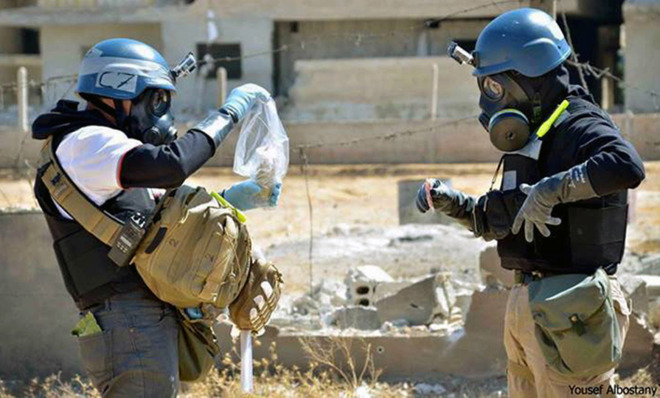Don't celebrate the news out of Syria just yet
Assad met the first deadline to destroy Syria's chemical weapons — but it’s not all good news

The international chemical weapons watchdog announced today that Syria had not only fulfilled its promise to destroy its chemical weapons production and mixing facilities, but that it had done so ahead of schedule. President Bashar al-Assad had until November 1 to complete the "functional destruction" of the sites, as part of a Russian-American deal brokered in September that averted the threat of American and French military strikes in the country.
In its statement, the Organization for the Prohibition of Chemical Weapons — who is overseeing the mission to destroy Syria's chemical weapons — said its team had "inspected 21 of the 23 sites declared by Syria, and 39 of the 41 facilities located at those sites." They concluded that "the joint mission is now satisfied that it has verified — and seen destroyed — all of Syria's declared critical production and mixing/filling equipment."
The director-general of the organization, Ahmet Uzumcu, this week welcomed the returning group of eight inspectors back to their headquarters in the Netherlands, and saluted their "fortitude and courage." Meanwhile independent chemical weapons disarmament specialist Ralf Trapp hailed the news as a "major milestone in the effort to eliminate Syria's chemical weapons program."
The Week
Escape your echo chamber. Get the facts behind the news, plus analysis from multiple perspectives.

Sign up for The Week's Free Newsletters
From our morning news briefing to a weekly Good News Newsletter, get the best of The Week delivered directly to your inbox.
From our morning news briefing to a weekly Good News Newsletter, get the best of The Week delivered directly to your inbox.
But don't pop the champagne corks just yet. At least two troubling questions remain:
1. Missing sites
What about the sites that inspectors were unable to visit? The OPCW openly admits in its statement that it couldn't inspect two out of the 23 sites due to "safety and security concerns;" that comes as no surprise, given that inspectors are carrying out their mission in the midst of a deadly civil war. Michael Luhan, a spokesman for the OPCW, said that the first site was in the area around Damascus. More worryingly, the second was near the town of Safira in the northern Aleppo area. Safira is apparently surrounded by jihadis; the region has come under government bombardment in recent weeks as Assad tries to force back rebel fighters, including Islamists linked to al Qaeda, who would undoubtedly love to get their hands on the weapons.
How worried should we be about these two sites — and especially the second? The OPCW assures us that Assad has declared the facilities "abandoned." We'd better hope he's right.
A free daily email with the biggest news stories of the day – and the best features from TheWeek.com
2. Toxic materials
Then there's the small matter of the chemical ingredients themselves. Though Syria has destroyed its equipment for making and filling chemical weapons, there are still 1,290 tons of toxic ingredients that need to be destroyed by mid-2014. Getting rid of those will prove far more difficult; as NPR points out, the three main options for disposal seem equally flawed:
Option A: Dump in the ocean. This was the method of choice for major world powers after World War II. The countries loaded approximately 300,000 tons worth of weapons onto ships, and simply dumped them into the sea. But the chemicals leaked out of their drums, burning beachgoers and killing fishermen.
Option B: Incineration. Moving into the Cold War-era, the U.S. and Russia decided to use custom-built incinerators to burn the chemical material. But then officials realized they would have to modify the incinerators to deal with all the toxic exhaust that was created in the process; something that would be too expensive and time-consuming for Syria.
Option C: Hydrolysis. The most plausible option is to move the material out of Syria, and then break the chemicals down using hot water and bleach. The waste created in this process still needs to be treated, but is a lot less dangerous. The problem with this method is that the OPCW would have to find a country willing to accept the chemicals. Norway has already declined, saying it lacked the necessary equipment and was forbidden by law from storing the chemical waste produced during the process.
Hopefully the international community will be able to find a country willing to take all the ingredients and destroy them by 2014. In the meantime, the bigger worry is whether Islamist fighters are able to find any chemical weapons in Safira. If so, the consequences could be devastating.
Frances Weaver is a senior editor at The Week magazine. Originally from the U.K., she has written for the Daily Telegraph, The Spectator and Standpoint magazine.
-
 Political cartoons for December 7
Political cartoons for December 7Cartoons Sunday’s political cartoons include the Trump-tanic, AI Santa, and the search for a moderate Republican
-
 Trump’s poll collapse: can he stop the slide?
Trump’s poll collapse: can he stop the slide?Talking Point President who promised to ease cost-of-living has found that US economic woes can’t be solved ‘via executive fiat’
-
 Codeword: December 7, 2025
Codeword: December 7, 2025The daily codeword puzzle from The Week